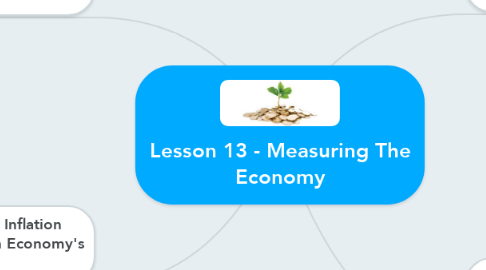Lesson 13 - Measuring The Economy
by Jacob Brandt


1. 13.2 - How Do Economists Measure the Size of an Economy?
1.1. Gross Domestic Product (GDP) Combination of Four Componants
1.2. Household Consumption, Business Investment, Government Imports, and Net of Exports Minus Imports
1.3. GDP Is Then Adjusted for Inflation
1.4. Nominal GDP - GDP Not Adjusted for Inflation
1.5. Real GDP - GDP Adjusted for Inflation
2. 13.5 - How Does the Business Cycle Relate to Economic Health?
2.1. The Business Cycle is a very good indicator of the economy's health.
2.2. As businesses employ more people, they spend more and the economy is strong, if they lay off people, these people spend less, causing the economy to fall.
2.3. When the Business Cycle has peaked, in theory, so should the economy.
2.4. Depression - Economic term in which the economy takes a nose dive, and the real GDP falls for a prolonged period of time.
2.5. Recession - Same as depression, but shorter in time. Can become a depression if conditions do not improve.
3. 13.3 - What does the Unemployment Tell Us About an Economy's Health?
3.1. Four Types of Unemployment - Frictional Unemployment (Between Jobs), Structural Unemployment (Advances in Technology Eliminate Job), Seasonal Unemployment, and Cyclical Unemployment (Based on Amount of Jobs)
3.2. When economy is low, people spend less. when people spend less, businesses make less and layoff employees because of it. It repeats this cycle.
3.3. Frictional and Structural Unemployment will always exist
3.4. Unemployment Rate - Percentage of people in the workforce looking for work that are not currently employed.
3.5. Underground Economy - Economy through illegal means, includes sex trade and drug sales.
4. 13.4 - What Does the Inflation Rate Tell Us about An Economy's Health?
4.1. Generally, an increasing inflation rate means the economy is decreasing.
4.2. When Deflation happens, the economy is improving.
4.3. Inflation in the US increases on average 3.2% every year
4.4. Inflation - The value of the dollar is decreasing
4.5. Deflation - Value of the dollar is increasing, usually associated with a healthy economy.
4.6. Table of Inflation Rate from 1914 in USA: http://www.usinflationcalculator.com/inflation/historical-inflation-rates/
4.6.1. You can see the changes in the inflation, and deflation, as seen in 1921 where deflation is very obvious
